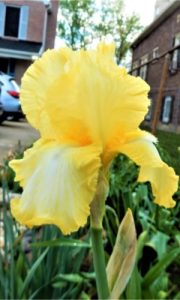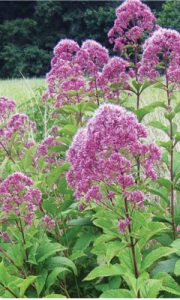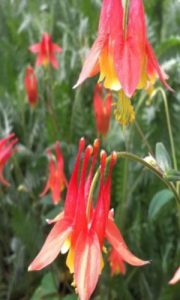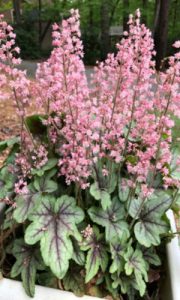For those of you who love flowers but have limited time or energy to care for them, consider a few no fuss perennials for sun or shade. The wonderful thing about perennials is that they return year after year. Saving you time and the expense of purchasing new plants each spring. Annuals bloom all summer, never varying, but most perennials bloom for two to four weeks, giving you an ever-changing parade of color and something new to look forward to during the growing season. In addition, perennials come in an array of flora and foliage to delight the senses without much upkeep. Whether you are looking to create an attractive garden in full sun or one with little to no direct sunlight there are perennials that will meet your needs.

To have something in bloom from spring to late fall in your sun-filled garden, it’s helpful to plan for bloom succession. Peonies and Iris bloom in early spring along with many bulbs. The perennials that follow, such as salvias, penstemon (beardstongue), cranesbill geraniums, and veronica will help hide aging bulb foliage. Summer brings nepeta (catmint), hemerocallis (dayliles), asclepias tuberosa (butterfly milkweed), monarda (beebalm), hibiscus, leucothoes (shasta daisies), lavender, and perennial poppies to your sunny garden. Late summer stars include, rudbeckia (black-eyed susan), heliopsis (false sunflowers), achillea (yarrow), and Agastache (hyssop or hummingbird mint). The growing season in your sun garden finishes with fall asters, eutrochium purpureum (joe-pye weed), chyrsanthemums, and the ornamental grasses that will provide winter interest. Many of these perennials are native and will attract pollinators and/or provide seed for songbirds and small mammals. Another benefit is that many of these perennials spread or reseed, providing extra plants at no cost.

Shady gardens typically aren’t as flower-filled as sunny ones. Making flowers takes a lot of energy, which plants get from sunlight. The less sun available, the less energy the plants have and the fewer flowers they produce. This does not mean you won’t have flowers at all, it just means that most of them won’t be as big and abundant as you would find in a sun-filled location (at least during the summer and fall). Gardens under deciduous trees can be absolutely spectacular in spring, when many woodland wildflowers take advantage of the ample sunlight before the trees leaf out and block the sun.
In the fall, consider planting spring blooming bulbs such as daffodil, crocus, snowdrops, grape hyacinth. These will all bring much welcomed color, to your spring garden. Also consider spring-blooming non-native flowers such as English primrose (primula vulgaris), Solomon’s Seal, Wake Robin (trillium grandiflora), Dutchman’s Breeches (Dicentra cucullaria). Definitely consider planting some of our amazing natives including, Wild Columbine (Aquilegia canadensis), Common Jack-In-The-Pulpit (Arisaema triphyllium), Bellwort (Uvularia grandiflora), Spring Beauty (Claytonia virginica), Dwarf Crested iris (Iris cristata), Woodland Phlox (Phlox divaricata), and Common Blue Violet (Viola sororia). All of these native and non-native perennials are examples of no- fuss early bloomers suitable for your “not so shady” spring shade garden.

As the season progresses other no-fuss perennials can be added. Starting at the back edge of your garden bed consider planting taller plants (3-4 feet) such as; Bleeding Heart (Dicentra spectabilis), Astilbe, and taller varieties of Hosta. Towards the middle of your bed place medium tall plants (18-24 inches) including; Hellebores, Coral bells (heuchera), Jacob’s Ladder (Polmonium caerulium), Spiderwort (Tradescantia) and Foamflower ( Tiarellia cordifolia). At the front of your garden border place lower growing (6- 12 inches) shade lovers such as Wild Ginger (Asarum caudatum), Wild Geranium (Cranesbill), Sweet Woodruff (Galium odoratum), Green and Gold (Chrysogonum virginianum), Lungwort (Pulmanaria officialis), Wild stonecrop (sedum ternatum), and Barrenwort (Epimedium).
In addition to shade-loving, blooming perennials, shade-loving foliar plants are a must have in your limited sunlight garden. Ferns, hostas, and certain woodland grasses and sedges fall into this category. These plants add color and texture to your shade garden. Hostas come in a variety of sizes from giants, which are taller than 28 inches, small hostas, which are 8 to 12 inches and minis, which are less than 8 inches. There are also hostas which fall into the medium and large category. Hostas also come in a variety of different colors. Shades of blue, green, variegated, and yellow, white with green edges, green with yellow edges, etc. In other words, if it fits the space you have and you find a color that you like, it’s most likely a good choice. Buy it. Plant it. Enjoy!

Ferns are another wonderful low-maintenance option for your shade garden. They too add texture and visual interest. Northern Maidenhair fern (Adiantum pedatum) grows to 1 ft. in height in full to partial shade. It is especially happy growing underneath deciduous trees. Southern Lady fern (Athyrium asplenioides) can reach heights of 3ft. and thrives in full shade though will tolerate some morning sun. Other ferns appropriate for your shade garden include the Sensitive Fern (Onoclea sensilbilis), Cinnamon Fern (Osmundastrueum cinnamomeum), Marginal Wood Fern (Dryopteris marginalis), and Christmas Fern (Polystichum acrostichoides).
Whether you are growing plants in full sun or full shade or somewhere in-between there will always be challenges as well as benefits. Challenges include hungry deer, pesky voles, a myriad of tree roots, and weeds. While no fuss perennials generally look after themselves, your garden will always need some sort of maintenance whether it is pulling weeds, transplanting/dividing, mulching or an occasional pruning. No fuss is not the same as no maintenance.
Remember, choose the right plant for your site conditions and over time you will have a beautiful and peaceful retreat.
Resources: A Guide to Gardening With Southwest Native Plants; Smithsonian Encyclopedia of Garden Plants For Every Location; The Perennial Gardener’s Design Primer by: Stephanie Cohen and Nancy J. Ondra, and The Ultimate Flower Gardener’s Top Ten List by Kerry Ann Mendez.








